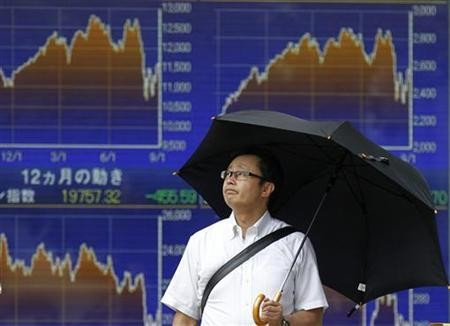Australia, Japan, New Zealand and Thailand to Weather Asia-Pacific GDP Storm

Ratings agency S&P revealed that Australia, Japan, New Zealand and Thailand will boost the overall Asia-Pacific region's real GDP growth over the next few years, after the deepening Eurozone crisis and subsequent austerity measures and faltering economies, weigh heavily on the region.
According to S&P's latest report titled 'Asia-Pacific Real GDP Growth Forecasts: Economic Uncertainties Continue,' the ratings agency predicts that as part of its "baseline scenario for a majority of Asia-Pacific economies [will show] slower growth in 2012."
"Notable exceptions are Australia, Japan, New Zealand and Thailand. These countries have rebounded after several natural disasters, including floods, a tsunami and earthquakes in 2011. Assuming a continuing upward trend in the US and a return to growth in Europe in 2013 and 2014, we expect economic activities in the Asia-Pacific countries to pick up," said analysts at S&P.
Troubles within the European Economic and Monetary Union (EMU or Eurozone) have significantly dampened export prospects and investment sentiment in the Asia-Pacific region for the last two years.
Bric countries that include Brazil, Russia, India and China have all been tipped as the key areas of growth at a time of turmoil but slowing GDP growth has shown otherwise.
In S&P's report, real GDP growth forecasts and estimates for rated Asia-Pacific countries are based on three alternate scenarios--base case, downside, and upside--for 2012, 2013, and 2014.
In S&P's downside scenario, China's GDP growth is set to slow to 6.8 percent in 2012 and 7 percent for the two following years.
Forecasts for India, under the downside scenario look just as bad. S&P predicts that India's GDP growth could slump to 5.1 percent by the end of the year.
However, Australia, Japan, New Zealand and Thailand GDP growth rates are forecasted to still remain relatively stable with no vast drop-offs in growth.
Mixed Bric resilience
Over the last couple of years, the Bric countries have had to fight for its status as a safe haven for investment and retain a hardy resilience to the rest of the world's economic woes.
India in particular has had experienced significant declines in GDP growth and economic stability through a deterioration of policymaking and governance, as well as absorbing some of the Eurozone's macroeconomic shocks.
Standard & Poor's said India could become the first of the BRIC economies to lose its investment-grade status and move into junk territory if it did not curb inflation, stem falling GDP growth and improve on governmental policymaking and governance.
"The combination of a weakening political context for further reform, along with economic deceleration, raises the risk that the government may take modest steps backward away from economic liberalization in the event of unexpected economic shocks. Such potential backward steps could reverse India's liberalization of the external sector and the financial sector," said S&P credit analyst Joydeep Mukherji, author of the report "Will India be the first BRIC Fallen Angel"?
As IBTimes UK has reported, the outlook for India has become increasingly troubling as the country battles against high inflation, consistent falling GDP growth and political turmoil.
The Reserve Bank of India (RBI) defied widespread expectations for an interest rate cut following high inflation and poor market performance and kept its key lending rate unchanged at 8 percent and its cash reserve ratio for banks at 4.75 percent, despite market consensus forecasting a 25 basis points rate cut.
RBI said that a "further reduction in the policy interest rate at this juncture, rather than supporting growth, could exacerbate inflationary pressures."
The move has already widely confused market analysts, as "the policy statement failed to provide much of a rationale for the central bank's decision apart from re-emphasising that interest rates have had only a limited role in the current growth slowdown. Forward guidance was also scanty," says Sanjay Mathur, Chief Economist (Non-Japan Asia) at RBS.
Meanwhile, although China has seen a major slowdown in its economy and has posted slowing GDP growth over the last year, it has to be remembered that the government, especially over the last 18 months, has been trying to engineer a slowdown and curb inflationary pressures.
Other Asia-Pacific Bright Spots
While Australia, Japan, New Zealand and Thailand are tipped to be boost the Asia-Pacific regions GDP levels over the next three years, IBTimes UK has previously reported that Singapore is a key beacon for growth.
Last month, another ratings agency Moody's Investors Service published a report highlighted Singapore as one of the most resilient economies.
The report probably comes as no surprise to those who watch the country closely or regularly operate deals and business in Singapore, but it is easy to forget when we hear troubling reports stemming from Asia, namely China, on battening down the hatches, stockpiling cash and energy and of course producing slowing GDP growth and steps to curb inflation.
Singapore's economy expanded by 10 percent in the first three months of the year from the previous quarter and growth has averaged more than 6 percent over the past five years. On purchasing power parity terms, it's the richest nation in Asia and ranks as the top global economy by the World Bank in terms of ease of doing business.
© Copyright IBTimes 2025. All rights reserved.






















